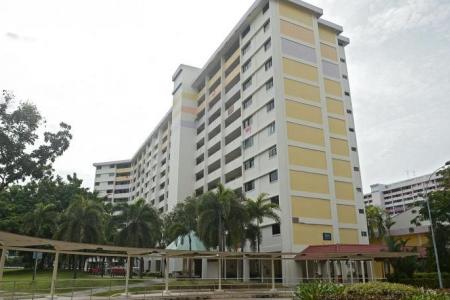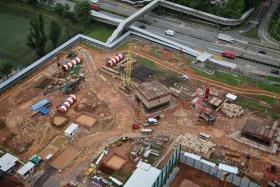Most affected home owners satisfied with Sers scheme
Madam Leong Chui Hwa was worried at first when her three-room Housing Board flat in West Coast Road was picked for the Selective En bloc Redevelopment Scheme (Sers) in 2016.
But the 66-year-old housewife, who has lived there for more than 20 years, was relieved when she secured a new three-room flat of the same size without having to top up any cash to buy it.
Her 68 sq m replacement flat in West Coast Crescent, about 1km away, is slated to be completed in the third quarter of next year.
Under Sers, owners of affected flats are offered monetary compensation for their units as well as a replacement flat with a new 99-year lease built at a designated site.
"I don't think Sers is a bad thing. With the price of homes increasing over the years, we are blessed to be able to get a newer one without having to pay extra," Madam Leong told The Sunday Times. Her flat was about 37 years into its lease at the time it was picked for redevelopment.
But not everyone has been as fortunate. Owners at four HDB blocks in Ang Mo Kio that were selected for Sers in April were dismayed when they learnt that they would have to make up the difference in the cost of similar-sized replacement units.
ERA Realty's head of research and consultancy Nicholas Mak said the reaction may have stemmed from residents not realising such substantial cash top-ups are sometimes needed.
"Topping up is not unusual for Sers," he noted. Still, the home owners might have expected to get more for their properties. "The flats there are around 43 years old and are located near the expressway - that could have affected their valuation," he said.
Home owners may have had higher expectations for their flat valuations, given that resale flat prices have been rising, agreed OrangeTee & Tie senior vice-president of research and analytics Christine Sun.
In response, HDB announced two new rehousing options: a shorter 50-year lease on the replacement flats, making them more affordable, and a lease buyback scheme for owners' existing flats.
Sers has been traditionally thought of as striking the lottery in getting a new subsidised flat, but a West Coast resident who wanted to be known only as Madam Chew was in two minds about it.
"I think it is unnecessary trouble as we are used to living here. My husband is also not able to move around easily, so moving will be a challenge," said the 80-year-old housewife, who has lived in a three-room flat there for over 40 years.
But Madam Chew added that she did not need to top up for a similar-sized replacement flat, and the fresh 99-year lease was a perk. "With the longer lease, my husband and I can now leave the flat for our two sons," she said.
Often, Sers poses a dilemma to older home owners, said experts.
National University of Singapore sociologist Tan Ern Ser said: "Older residents with low retirement financial adequacy cannot afford to fork out tens of thousands to purchase a new 99-year lease replacement flat." He said they may also be less motivated to move, unlike younger residents who see Sers as an opportunity for upward residential mobility.
In MacPherson Lane, for instance, where three 50-year-old blocks were selected for Sers in 2018, Madam Mohamed Dhaha Shameema Farvin was willing to top up some $250,000 for a 90 sq m four-room flat at its replacement site.
It is an upgrade from her current 60 sq m three-room home, which she purchased in 2015. "I think it's a good deal because we are able to get a new flat that's closer to the MRT station," said the manufacturing company director, 43.
However, home owners in other Sers exercises have voiced their unhappiness in the past.
When four blocks in East Coast Road were selected for Sers in 2011, some owners were unhappy that the replacement flats were some 2km away, in Chai Chee.
Likewise, when Rochor Centre's four blocks were acquired to build the North-South Expressway in 2011, the owners who were offered relocation benefits similar to those under Sers complained that the replacement flats were farther away, in Kallang.
By and large, however, residents have been satisfied with the process of flat renewal. An HDB survey in 2012 of 628 Sers households found that 87 per cent expressed support for the scheme. About 93 per cent of the surveyed residents were happy that Sers allowed them to continue living in the same estate, and 91 per cent thought the new flat offered was value for money.
Mr Mak added: "HDB is essentially buying back the flats at resale prices, and offering new replacement flats at subsidised BTO (Build-To-Order) prices.
"But if owners choose not to top up money and downsize their flats, they may not see it as a good deal, especially as the pandemic has shown that people do need more space."
All of the West Coast and MacPherson owners The Straits Times spoke to said they opted for the replacement flats offered to them.
Most said they were satisfied with the scheme. Those who chose a similar-sized flat did not have to fork out extra cash, while those who chose a bigger flat topped up at least $100,000.
West Coast resident Teo Kim Hua, 70, a retired manager, said he was glad he did not have to top up for a similar-sized three-room flat, but added: "Others may not see themselves as fortunate if they have to pay levies or top up more money for a new flat."
But even though MacPherson resident Christina Lian, 61, chose to top up over $100,000 for a larger four-room home, she said it was worth it.
The waitress said: "I think it's a good form of investment. With the new lease, we can leave the flat for our children, and they are free to sell it next time."
Get The New Paper on your phone with the free TNP app. Download from the Apple App Store or Google Play Store now


